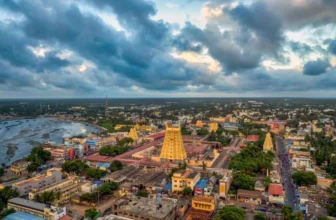Meenakshi Temple, Madurai: A Living Marvel of Urban Ecology and Symmetry
The Meenakshi Amman Temple in Madurai, Tamil Nadu, is not just a place of devotion but a living example of urban planning, symmetry, climate-conscious architecture, and cultural continuity. Dedicated to Goddess Meenakshi (a form of Parvati) and Lord Sundareswarar (Shiva), this temple complex is over 2,500 years old in oral tradition and was rebuilt in the 12th–17th centuries with unmatched precision.
🌺 What Makes Meenakshi Temple Unique?
- Temple Within a City — or City Within a Temple?
The temple was once the epicenter of Madurai, and the city was designed around it in the shape of a lotus flower — with concentric streets resembling lotus petals. This is sacred geometry in urban planning — balancing spiritual symbolism with practical design for defense, trade, and community life. - Symmetry & Vastu Shastra Precision
The temple layout follows ancient Vastu Shastra principles with perfect axial alignment, symmetrical architecture, and intentional directional placement of shrines. Researchers note that the plan maximizes energy flow, sunlight, and natural ventilation — an early example of bioclimatic design. - Thousand-Pillar Hall (Aayiram Kaal Mandapam)
This hall contains 985 elaborately carved pillars (not exactly 1000, interestingly), and the arrangement is so symmetrical that from any angle, rows of pillars appear perfectly aligned. The pillars also serve an acoustic function, minimizing echo and amplifying devotional chanting — a stone-based sound engineering technique. - Climate-Conscious Water Tank: The Golden Lotus Pond
The Porthamarai Kulam (Golden Lotus Tank) inside the temple is more than a sacred water body — it’s part of a rainwater harvesting system and plays a key role in temperature regulation of the temple complex.
During scorching summers, this water body and surrounding corridors keep the microclimate cool — a traditional method now being re-examined in sustainable architecture. - Granite Flooring for Heat Control
The temple uses polished granite extensively — a stone known for its high thermal inertia, meaning it absorbs heat slowly and radiates it evenly, maintaining ambient indoor temperature even during extreme heat. This is why devotees feel coolness underfoot even on the hottest afternoons. - Musical Pillars and Acoustic Resonance
Some pillars in the temple, when struck, emit musical notes (sapta swaras). These are called “musical pillars” and show that artisans had knowledge of vibrational acoustics, tone calibration, and the physical properties of materials — centuries before modern acoustics. - Crowd Flow and Energy Circulation
The temple’s vast corridors, multiple entryways, and directional movement (pradakshina) are not just spiritual in purpose. They are designed to naturally regulate crowd flow, maintain air circulation, and even channel collective energy through synchronized motion — a concept that aligns with biophilic design and behavioral architecture.
🔍 Scientific Uncovers & Insights:
- Environmental Harmony:
Studies by ecological architects have found that the Meenakshi Temple complex is a zero-waste zone, with efficient use of water, space, and air — all based on ancient engineering knowledge. The tank helps replenish groundwater, and plant life within the premises adds to biodiversity. - Material Intelligence:
Granite’s use is not only structural but also anti-bacterial and wear-resistant — ensuring longevity and hygiene in a high-traffic public space. - Cultural Sustainability:
Daily rituals, festivals, and community functions still happen as they did centuries ago. The temple is not a relic — it’s a living system, preserving socio-religious, ecological, and economic sustainability.
🛕 Conclusion:
The Meenakshi Temple isn’t just a spiritual abode; it is a masterclass in sustainable urban planning, energy-efficient architecture, and social engineering. Its traditions — once seen as merely religious — are now being reevaluated through the lens of science as practices grounded in natural law and environmental intelligence.
It stands as a symbol of how ancient Indian temple builders were not just artists and priests — they were scientists, ecologists, and architects of the cosmos.










